Table of Contents
ToggleIntroduction
If you were after a high-performance Socket A board in early 2002, you probably had the Abit KR7A(-RAID) on top of your list. Abit's KT266A board is a true classic of its generation and among the best OC boards of that time.
It was brought to market several weeks later than the KT266A boards from most other major manufacturers, but in exchange, Abit managed to release (to my knowledge) the only KT266A board with 4 RAM slots, with support for 4 GB (registered) / 3 GB (unbuffered) of memory. It offers 6 PCI slots for expansion, Abit's trademark SoftMenu III BIOS section with lots of overclocking and tweaking options and was also extremely stable right from the start.
It was offered with and without Highpoint RAID chip and was later re-released with the -133 suffix, featuring the updated VT8233A southbridge. In total, there exist 4 variants of the KR7A:
- KR7A
KT266A / VT8233 chipset, no RAID
- KR7A-RAID
KT266A / VT8233 chipset, HPT372 ATA133 RAID
- KR7A-133
KT266A / VT8233A chipset, no RAID
- KR7A-133R
KT266A / VT8233A chipset, HPT372 ATA133 RAID
Gallery
Specifications and Features
Chipset:
- VIA KT266A (VT8366A) Northbridge
- VIA VT8233 Southbridge
CPU Support (with latest BIOS):
- Athlon Thunderbird (ALL)
- Athlon XP Palomino (ALL)
- Athlon XP Thoroughbred (all FSB266 models up to 2000+)
- Duron Spitfire (ALL)
- Duron Morgan (ALL)
Memory Support:
- 4 DDR DIMM slots, up to 3GB total (unbuffered) or 4GB (reg. ECC)
Expansion Slots:
- 1x AGP slot (1,5 / 3,3V) up to 4x
- 6x PCI slots
Connectors (internal):
- 2x IDE (UDMA100)
- 2x IDE RAID (UDMA133)
- 1x Floppy
- 4x USB 1.1
- 4x 3-pin fan connectors total (1x CPU, 3x chassis)
Connectors (external):
- 2x PS/2
- 2x COM/RS-232
- 1x Parallel Port
- 2x USB 1.1
I consider the lack of an onboard audio solution as a plus, as I think far better solutions than the old onboard chipsets are readily available for little money. Very commonly recommended are the Creative Soundblaster Live! cards for example, which offer fantastic compatibility with our beloved old games and sound far better than any onboard solution of that era.
I also don't list (from a retro-gamers perspective) useless connectors and features like IR, Smartcard- or Wake-on-LAN connectors and so on.
Overclocking Features:
- Adjustable Multiplier (BIOS) from x6 to x13 and "Over x13"
- Adjustable FSB (BIOS) from 100 to 250 MHz in 1 MHz steps
- Adjustable VCore (BIOS) from 1,100 V to 1,850 V in 0,025 V steps
- DDR Voltage (BIOS): 2,55 V to 2,85 V in 0,10 V steps
- I/O Voltage (BIOS): 3,50 V / 3,65 V
- Dividers: FSB/AGP/PCI 4:2:1 and 3:2:1
Documentation, Downloads, Drivers
There are many manufacturers of the early socket A era, that do not exist anymore. Sadly Abit is also among them, as they closed doors by the end of 2008. Therefore it is not necessarily an easy task to obtain bios files, drivers and documentation, since you can't simply go to the manufacturer's website and download the required files.
There is a copy of the original website “www.abit.com.tw” which can be accessed via http://abit.ws, but some parts of the site do not work anymore and the downloads are also (mostly?) broken. Fortunately, the latest BIOS files can be obtained on this fantastic website: https://soggi.org/motherboards/abit.htm
There are also driver downloads for a huge share of old chips (network, storage, chipset, etc.) available on this part of the site: https://soggi.org/drivers/drivers.htm
In terms of documentation, there exist many websites that offer a huge amount of manuals.
Here is one of them, that I already used several times:
https://www.manualslib.com/brand/abit/motherboard.html
Alternatively, here is a FTP mirror of Abit's manuals: https://downloads.bl4ckb0x.de/ftp.abit.com.tw/pub/download/manual/
Please note, that not all manuals are available at any language there.
Regarding CPU support you can find the info here: https://www.cpu-upgrade.com/mb-ABIT/index.html
I already use this site for a long time and I always found the info to be very accurate. I cannot remember that I had a motherboard, that was not featured there. Great site.
To sum it up: using a motherboard of a manufacturer that is not around anymore might not be as straightforward as using an Asus or Gigabyte motherboard, for example. But, especially with an iconic brand like Abit, it is not an impossible thing to do.
Design & Layout
If you don't need or use the IDE RAID ports and your floppy cable is long enough, the board's layout is almost perfect. The very fact that we have a board with six PCI slots here and the AGP card does not block the memory slots, deserves praise. There are very few Socket A boards with six PCI slots out there, where this is the case. Another great aspect of the layout is the location of the ATX power connector. With its position right on the top edge of the board, to the right of the CPU socket, it is easy to keep the ATX power cable out of the airflow for all the hot areas around the CPU.
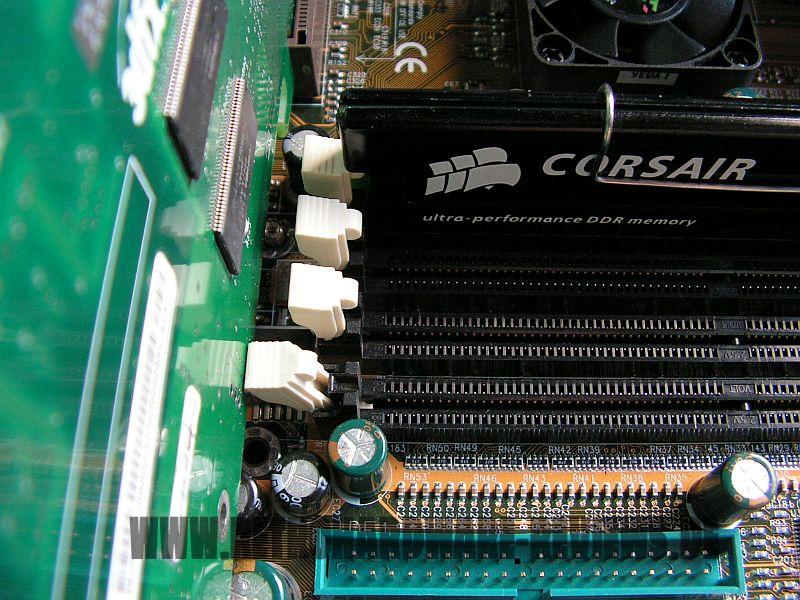
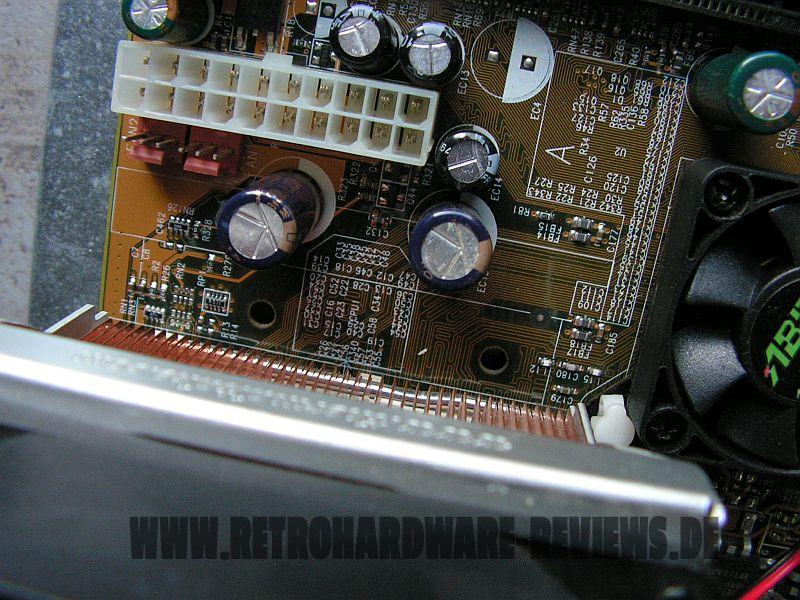
The onboard IDE connectors are placed perfectly at the right edge of the board, the Floppy connector, however, is located in the lower right corner and oriented “upwards”. This wastes a bit of the floppy cable length, if you want to route it downwards and then up again behind the PCB, because you have to bend it backwards.
This is the case with the IDE RAID connectors as well, which are in the same spot. Since they are located above the floppy port, the length of standard IDE cable will not suffice to route the cable the same way, so you have to route them upwards. And no matter how you do it in the end, the cables will either severely affect the airflow, look messy or both at the same time. Furthermore, long PCI cards like Voodoo2s will interfere with the connectors.
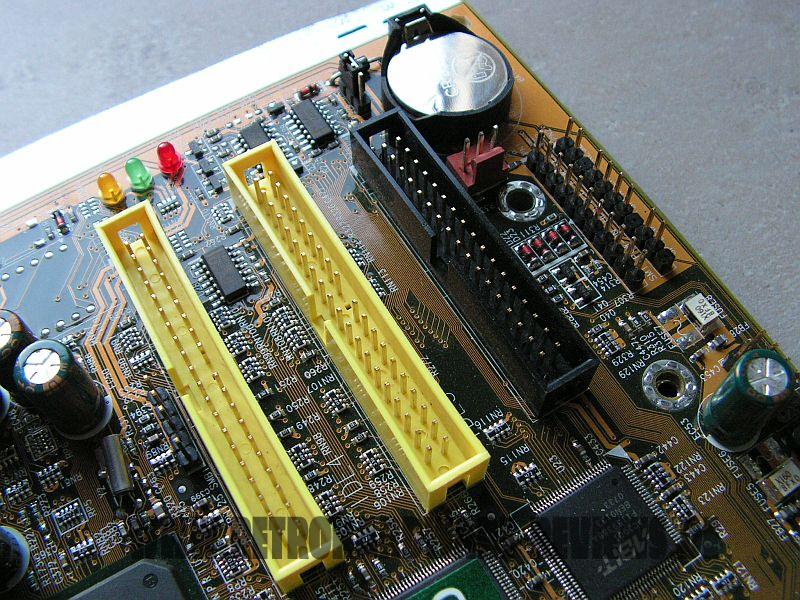
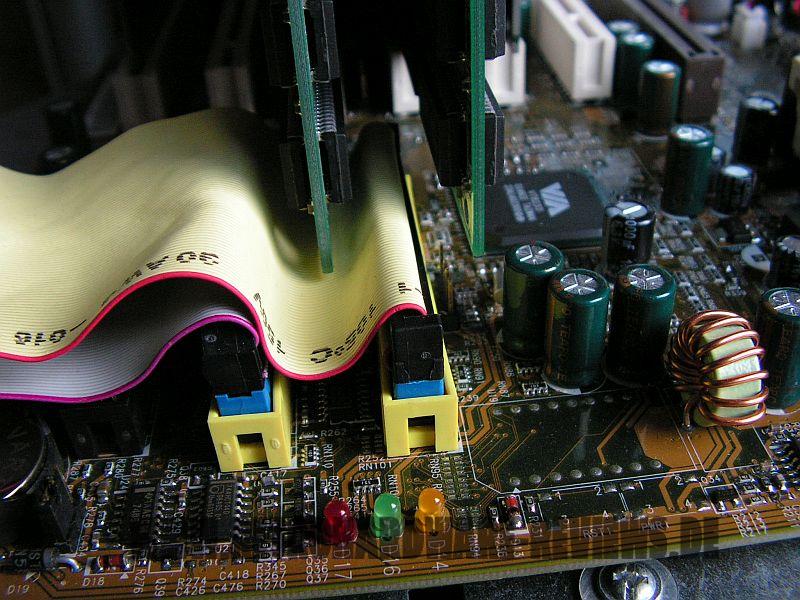
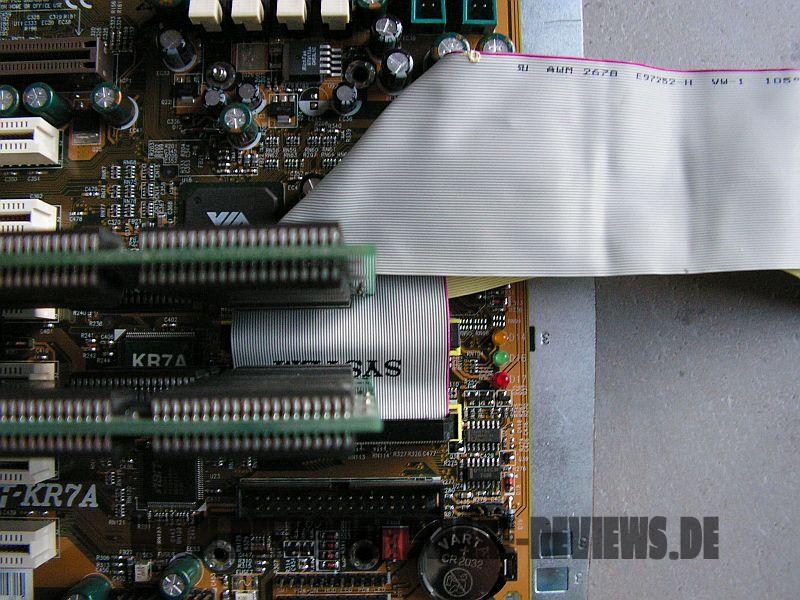
The CMOS battery, on the other hand, is perfectly accessible in the bottom right corner of the board, where also the Clear CMOS jumper, a front fan connector, as well as the front panel connectors are located. Besides this fan connector, there are also two fan connectors near the CPU socket (which is great for fancy old dual-fan CPU coolers) and one more connector, which is placed perfectly for the connection of a rear fan.
Slightly above the CMOS battery, we have three small LEDs in yellow, green and red. The yellow LED indicates power and will turn on, as soon as the board is supplied with power. When the system is turned on, the green LED will turn on in addition; the red LED indicates a push of the reset button.
The Cooler compatibility of the KR7A(-RAID) is a bit of a mixed bag. On the one hand, there is enough space around the CPU socket to fit even very large coolers and have them install quite easy. On the other hand, the CPU socket is located very close to the top edge of the board. This can make the board hard to fit into some cases, if a large cooler is installed. Also, you have to disassemble the whole system to remove the CPU cooler, because the access to the cooler's mounting clamp will most likely be blocked by the PSU on the upper side.
I checked the following seven coolers towards compatibility with Abit's KT266A flagship:
- Thermaltake Silent Boost K7
- Cooler Master HHC-001
- Swiftech MCX 370
- Alpha PAL 6035
- Alpha PAL 8045
- Smartcooler 60mm
- Arctic Cooling Copper Lite
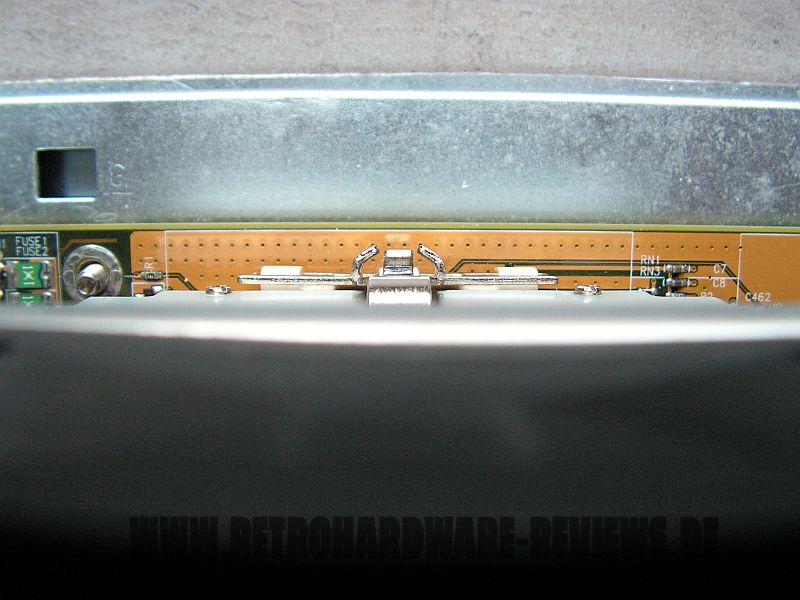
In general, all of these fit fine and are easily installed. A small exception is Cooler Master's HHC-001, which has its lever reach over the edge of the PCB quite a bit. This should be "enough" to have it collide with the PSU in most classic computer cases. Furthermore, both heatpipes make contact with capacitors to the right of the CPU socket. But I would consider this less of a problem compared to the aforementioned issue.
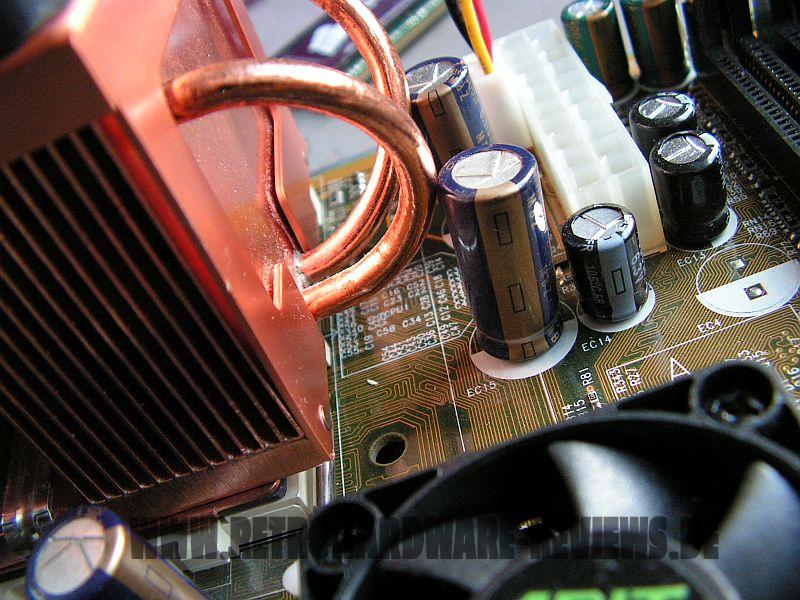
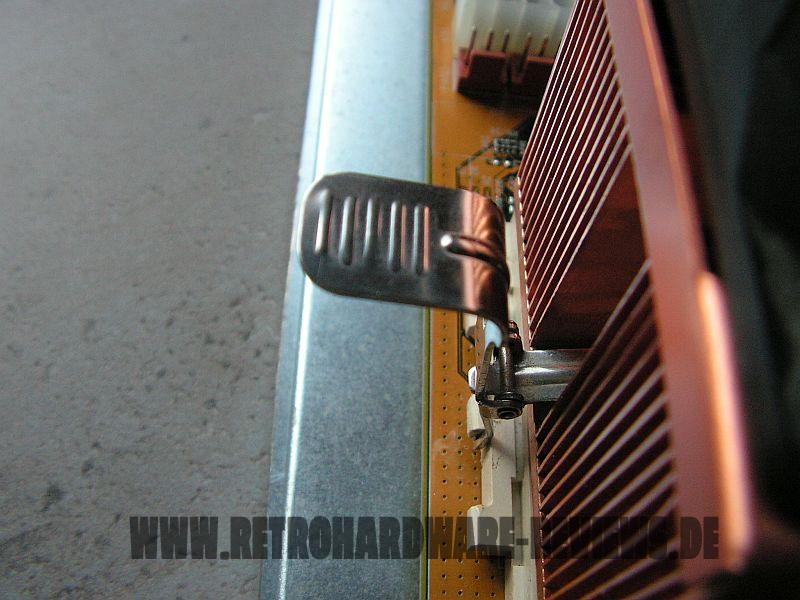
The Abit KR7A is also one of the few boards, where the installation of the Arctic Copper Lite is not a complete nightmare (if it even fits, that is). Its wobbly mounting clamp is easily accessible and it doesn't collide with the caps below the CPU socket. The big Alpha PAL8045 fits fine as well, although it protrudes a tiny bit beyond the top edge of the PCB. But I don't think it is enough to collide with the PSU, so no big issue there.
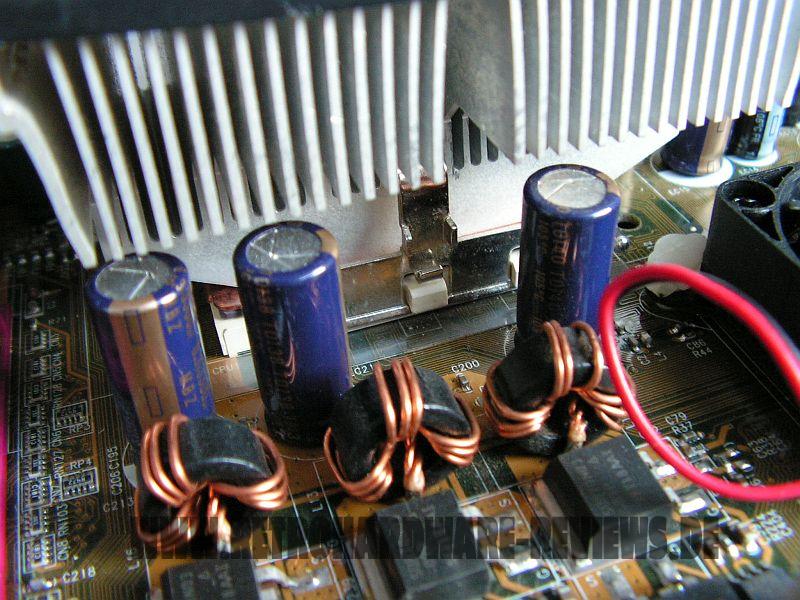
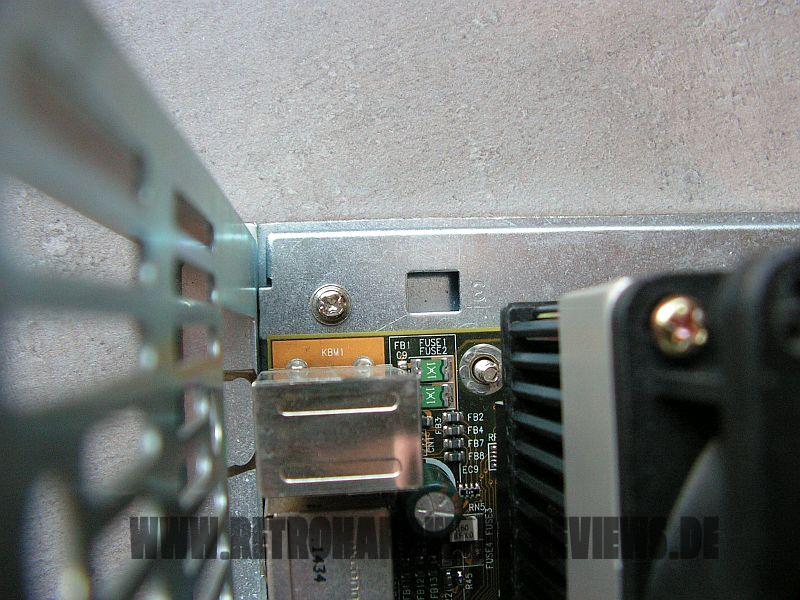
One great feature that deserves mentioning, is the presence of four memory slots. This is a standout feature among KT266A based motherboards and does not come with limitations on how the modules are organized. You can install up to four dual-ranked modules, with a maximum module size of 1 GB and a total maximum of 3 GB (unbuffered) or 4 GB (registered) of memory.
Test-System and Parts
Baseline Setup:
- CPU: AMD Athlon Thunderbird 1200C (FSB133)
Because I want to compare 1st Gen Socket A mainboards to their DDR follow-ups I have to use a CPU, which is available in FSB100 and FSB133 versions with the same clockspeed. Since I sadly don't have a Thunderbird 1400 B at my disposal, I will use the Thunderbird 1200 for my reviews and comparisons of these boards, which I have in the “B” (FSB100) and “C” (FSB133) version.
- RAM: 1x Corsair CMX512-3200C2 (XMS3202v4.2) = 512MB PC400 CL2
This Corsair XMS stick should allow the tightest timings at 266 MHz DDR and its size of 512MB is the perfect choice for Windows 98SE.
- VGA: MSI Geforce 4 TI4200-VTD8X
To remove any GPU bottleneck for testing, I chose a Geforce 4 Ti as the primary graphics card for my test setups. The Geforce 4 Ti series are also known to pull a lot of power from the AGP port, so that possible problems in that department can also be revealed. It is also somewhat period correct and a good match for a high performance retro-machine that should be able to run late Windows 98SE games without any issues.
- VGA2: 3dfx Voodoo 5 5500 AGP
Many people consider the Voodoo 5 5500 the perfect card for (Win9x-) retro gaming. The Voodoo 5 benefits from a beefy setup, so a powerful Athlon Thunderbird or early Athlon XP is the perfect match for this card.
- Audio: Creative Soundblaster Live! (SB0060)
Creative's Soundblaster Live! can be found in many retro-machines. It offers great sound, perfect Win98SE compatibility and is still widely available for reasonable money. It was also known to cause problems with VIA-based 686B southbridges using old BIOS revisions and VIA chipset drivers. All this should be history at this point, but double checking on pontentially affected mainboards is still not a bad thing to do.
- LAN: 3Com Etherlink XL PCI
Just a good, reliable choice for networking. All legacy Windows versions all the way up from Win95 have built-in drivers for it, which is also a huge “plus”.
- HDD: Western Digital WD200BB (20GB 7200RPM)
No special intention behind this drive, it is just “there” and still works fine.
Additional Hardware for certain Tests:
- Silicon Image Sil3512 SATA Controller & Samsung PM871 128GB SSD
These two will help me measure the PCI bandwidth.
- Hitachi Deskstar T7K500 (500GB 7200RPM)
This drive will tell us, how big we can go with the onboard IDE connectors and how the performance is like.
- 2x Voodoo 2 12MB (SLI)
A pair of Voodoo 2s is a must have for any retro-machine, that doesn't feature a 3dfx card as the primary VGA solution. They offer compatibility to older Glide games and can be used with any more powerful primary graphics card. It is an important thing to know, how well these perform and if there are differences between all the available Socket A chipsets of that era or even between boards using the same chipset.
Drivers used:
- Chipset: VIA Hyperion 4in1 4.56v
- Geforce 4: nVidia Forceware 43.45
- Voodoo 5: Amigamerlin 2.9
- Voodoo 2: FastVoodoo 4.6
- SB Live!: Some driver from my archive, not shure 😉
- 3Com NIC: Windows 98SE preloaded driver
- SATA Controller: Some driver from my archive, not shure 😉
System Setup and Usage
The setup of the KR7A-RAID was very easy and completely trouble-free. When first put together, the system boots with the FSB set to 100, which can then be configured jumper-free in the BIOS. In Abit's SoftMenu III, you can select from several CPU presets in a drop-down menu, which then sets the appropriate multiplier and FSB settings for the selected entry. Alternatively, you can setup all the parameters (plus several more settings like dividers and voltages) manually, when CPU Operating Speed and CPU Power Supply are set to User Define.
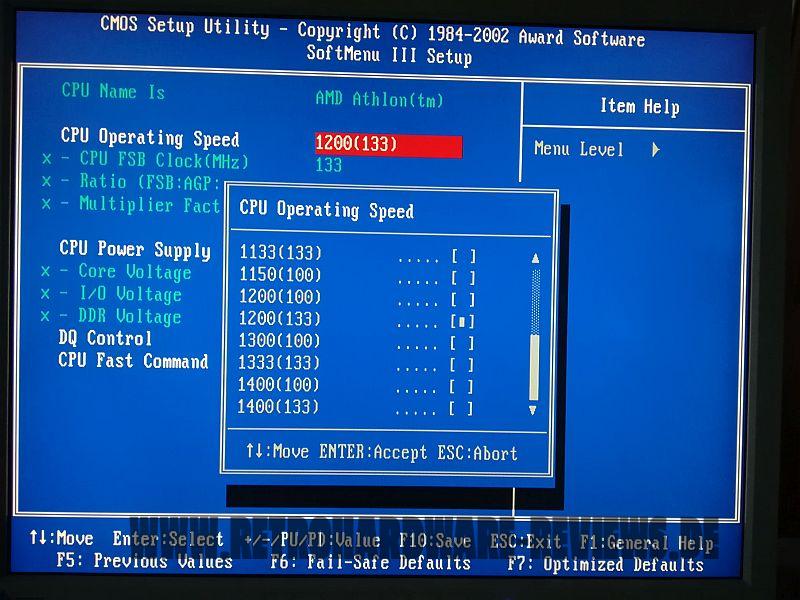
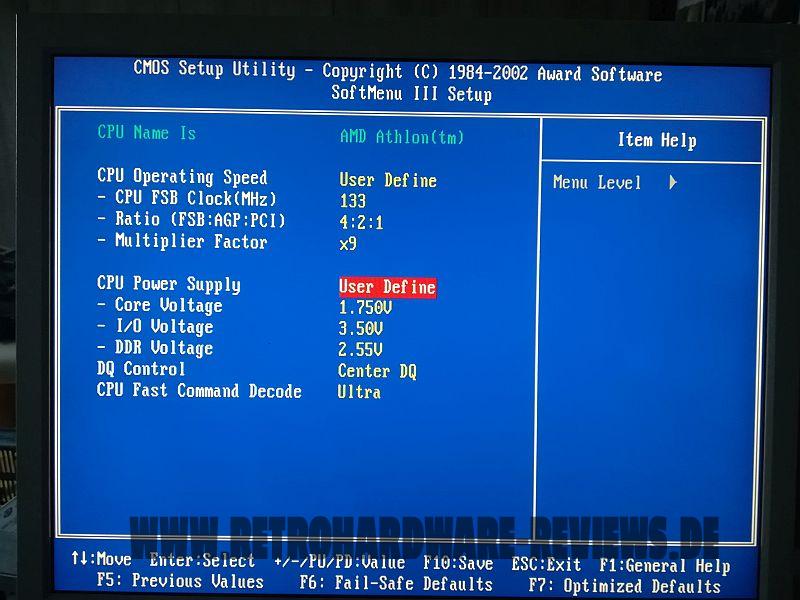
The board also proved to be perfectly stable with the fastest settings for memory and chipset applied (which are plenty!), which resulted in a DDR266 CL2 2-2-5 1T memory configuration. Thankfully, the descriptions of the various settings in the manual are really helpful and extensive. In this regard, Abit is unrivaled - most other manufacturers only list the available options and that's about it. Abit also included an INT routing table in the KR7A's manual, as well as information, on which INT line the onboard controllers allocate their IRQs.
This is the KR7A's INT routing, where we can see, that PCI #2 and #3, as well as PCI #4 and PCI #6 share ressources:

From the manual, we also get the information, that:
- PCI #1 is shared with the AGP slot
- PCI #4 is shared with the USB controller (this means so is PCI #6)
- PCI #5 is shared with the Highpoint RAID controller
Based on this information, my test-setup looked like this:
- PCI #1: free
- PCI #2: Soundblaster Live!
- PCI #3 + PCI #4: Voodoo 2
- PCI #5: Silicon Image Sil3512 SATA Controller (after the HPT RAID controller was benched and disabled)
- PCI #6: 3Com Etherlink XL PCI
This setup worked right away and gave me zero issues.
Benchmarks
Synthetic Measurements
Before we get into the 3DMark and gaming benchmarks, let's have a look at some theoretical numbers. These synthetic tests will exhibit the differences between the several chipsets and boards better than any game benchmark and provide us with "background information" that might be of use in understanding the timedemo results later.
Memory Performance: AIDA64 Cache & Memory Benchmark
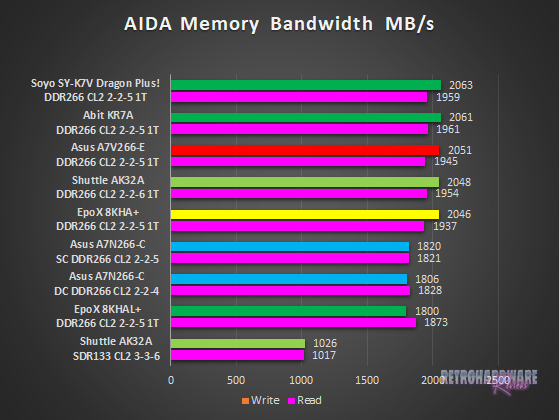
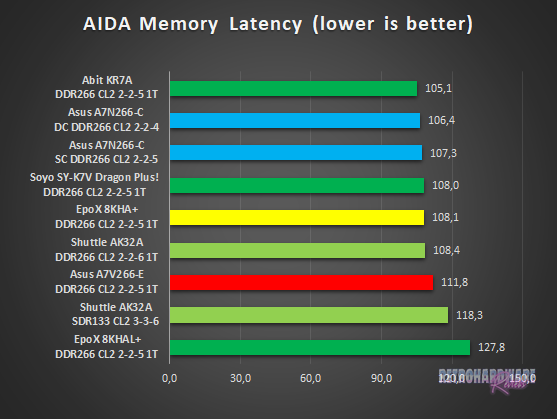
The Abit board shares the lead with Soyo K7V Dragon Plus! in the Memory Bandwith bench here. The KT266A based boards (with the exception of the Epox 8KHAL+) perform very similarly, but it is noteworthy, that the KR7A-RAID and Soyo's Dragon perform best, despite having a slight clockspeed disadvantage compared to most of the competition.
In the Memory Latency bench, the KR7A-RAID is the clear winner and the only board, that can beat the nForce-based Asus A7N266-C with both single- and dual channel memory configurations. An impressive result.
Application Performance: 7-Zip
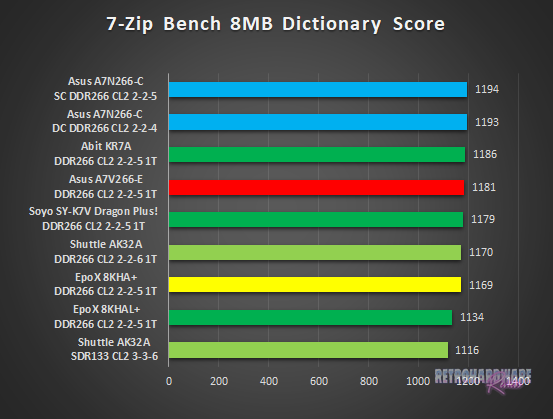
Yet again, Abit has the fastest KT266A based board in this bench, with only the A7N266-C scoring slightly higher in both memory configurations.
AGP Performance: Final Reality Benchmark
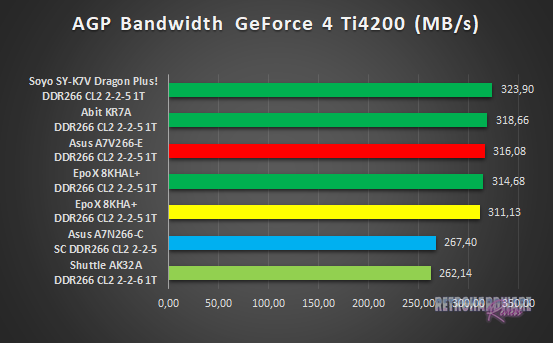
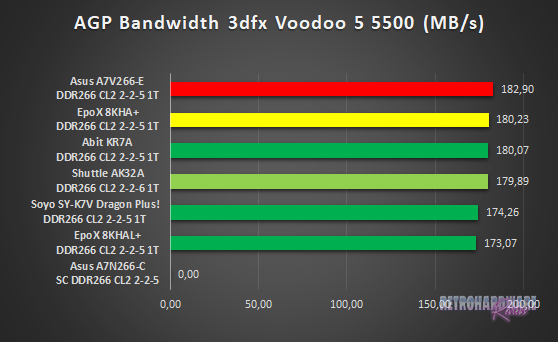
In the AGP bandwidth tests, the KR7A-RAID ranks second and third (GeForce 4 / Voodoo 5), with very little distance to the respective first-placed boards.
AGP and PCI Performance: 3DMark 2000 and ATTO
3DMark 2000 as a whole is very focused on TnL and is by far not as interesting for retro-hardware comparisons as its predecessor. Its “High Polygon Count, 1 Light” test, however, is another good way to measure the AGP performance. In opposite to the Final Reality test, the general system performance is also somewhat of importance. The benchmark was executed with the Geforce 4 Ti installed.
To measure PCI performance, I installed a Windows 98SE compatible SATA controller with a Samsung PM871 128GB SSD connected into the system. For the bench, I chose 1024 to 4096 KB block size and picked the overall best values for the read and write throughput. This test will show, which maximum performance can be expected with fast storage options like SATA or SCSI and maybe gives a hint, if the chipset might be good for Voodoo 2 cards.
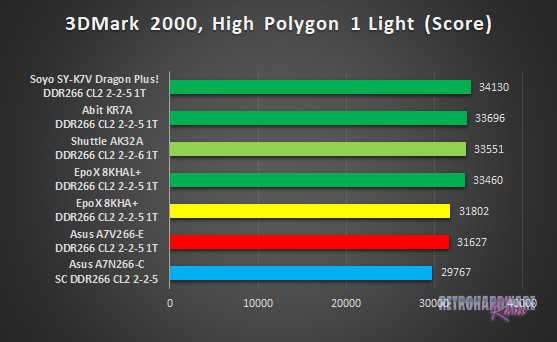
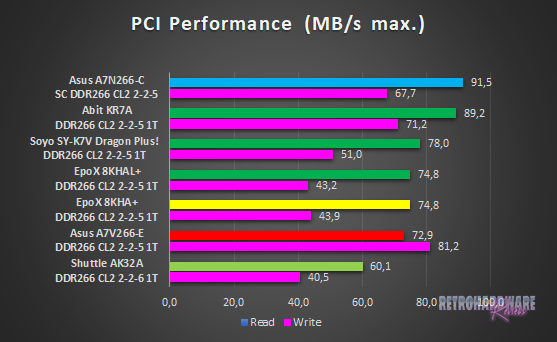
The KR7A-RAID takes second place in this 3DMark 2000 sub-test, only bested by the Soyo Dragon Plus!, which already showed a little more throughput in the Final Reality AGP bandwidth test.
The PCI bandwidth test also shows very good results for a KT266A based board. With 89,2 MB/s and 71,2 MB/s read/write throughput, Abit's board is a reasonable choice for fast storage options.
Storage Performance: HDTach
To measure the performance of the board's IDE and (if available) onboard IDE RAID solutions' performance, I benched one of the latest and fastest IDE drives (the Hitachi Deskstar T7K500 500GB) with the HDTach benchmark. I also tried a much more “recent” drive (the Western Digital Blue Edition 500GB), which should be even faster in theory, but the Hitachi drive produced much better results in this test.
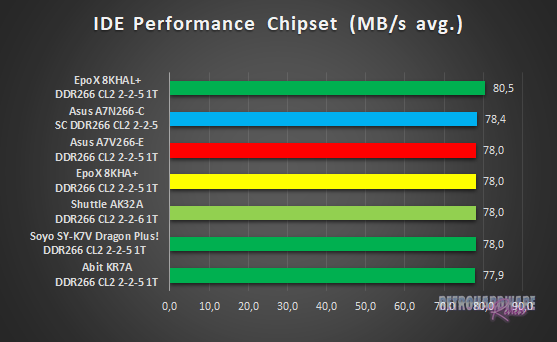
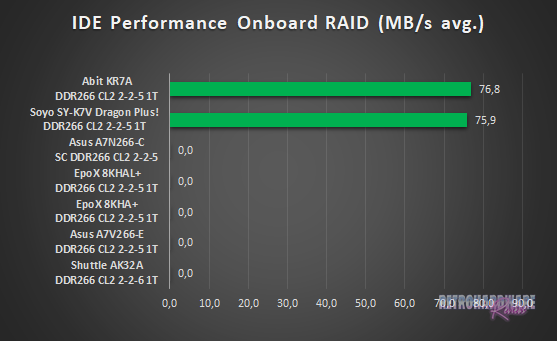
All boards perform very similar with the harddisk connected to the chipset's IDE ports. All KT266A based boards with the older VT8233 southbridge reach exactly (or almost, in case of the Abit KR7A) 78 MB/s, the nForce-based Asus A7N266-C is on a similar level with 78,4 MB/s. Only the Epox 8KHAL+ with the newer VIA VT8233A southbridge squeezes more than 80 MB/s out of the drive.
The KR7A's Highpoint chip is a little slower than the chipset's IDE ports, reaching 76,8 MB/s read speed. But at least it is the faster out of the two RAID chips tested, beating the Soyo K7V Dragon Plus' Promise chip by around 1 MB/s.
Gaming Benchmarks
Now that we got all the theoretical performance numbers, let's see how the contenders perform in 3D gaming benchmarks.
3D Performance: 3DMark99max
3DMark99max was released in early 1999 and comes without support for Hardware TnL. The maximum supported (hardware-) DirectX level is DX6. It is a great benchmark to reveal good overall system performance, as it rewards good memory bandwidth and latency more than the slight clockspeed advantage, that some boards have because of their factory-overclocked FSBs.
- Version: "latest"
- Settings: standard
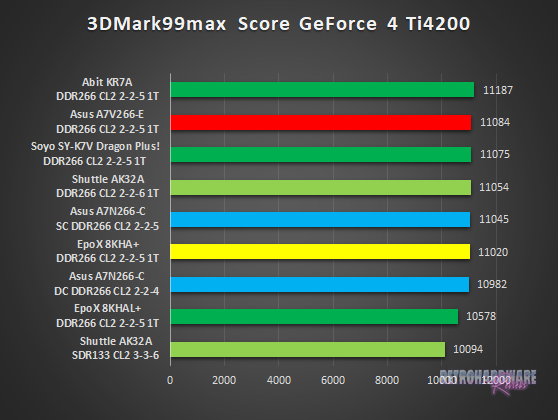
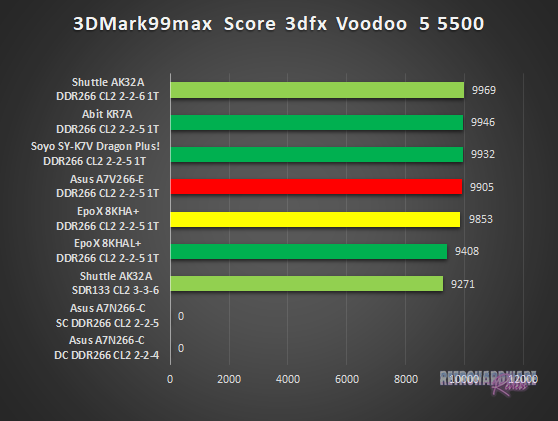
With more than 100 3DMarks ahead of the second place, the Abit KR7A-RAID ranks first in 3DMark99max with the Geforce 4 Ti installed. Considering that the the second and seventh placed boards are less than a hundred points apart, this is a pretty impressive result.
The results with the Voodoo 5 card are also very close, with the Abit board taking second place here.
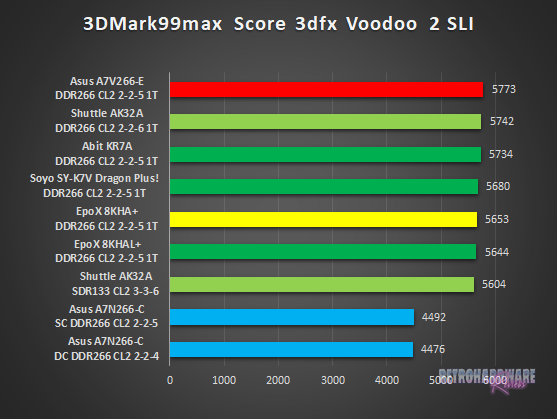
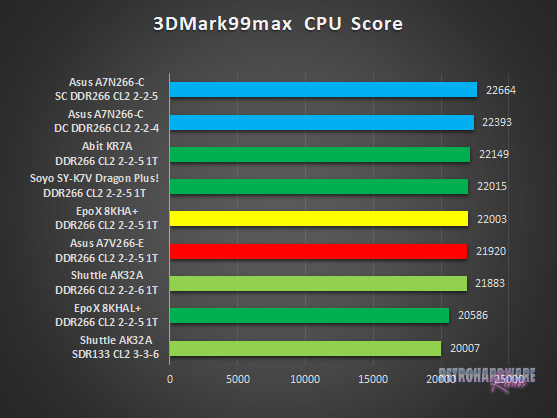
The pair of Voodoo 2 cards seem to run equally well on all KT266A based boards, as the results show very little variance.
3DMarks' CPU Score results are a little more interesting, as the Abit board scores higher than any other KT266A based board, despite the slight disadvantage in clockspeed it has to most of them. Only the nForce based Asus A7N266-C is faster.
3D Performance: Unreal Tournament (UT99) Timedemo(s)
Unreal Tournament (UT99) was released in November 1999 and is notorious for its hunger for CPU power. I chose to use two different timedemos for comparison, of which the utbench.dem timedemo is heavily CPU bound and therefore qualifies to measure the general performance of the boards. The second timedemo benchmark.dem is as GPU limited as possible in this game. This will reveal, how much impact a faster board can still have in more GPU limited situations. This game is also perfect to show, on which chipsets and boards Voodoo 2 cards run best.
- Version: 4.36
- Settings: High, Min desired Framerate "0", Show Decals [x], Use Dynamic Lightning [x]
- Geforce: D3D
- Voodoo 2 and Voodoo 5: Glide
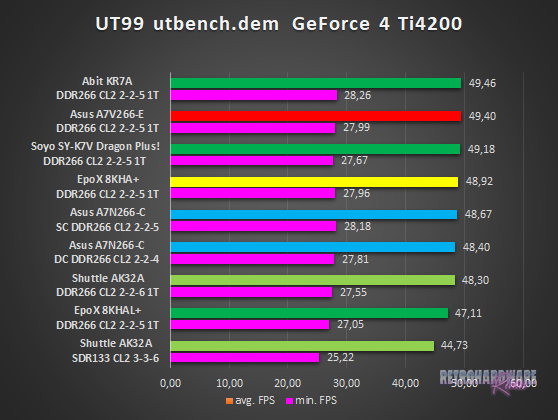
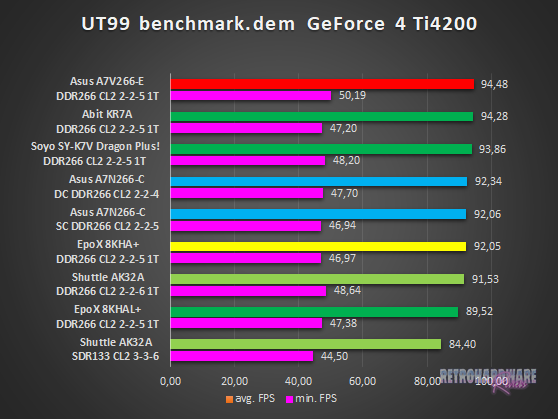
The CPU bound utbench.dem timedemo has the boards scoring fairly identical with few exceptions. The Abit KR7A-RAID scores first place, using the second timedemo it ranks second. While the results of the benchmark.dem timedemo seem to be very close too at first look, the top three boards can seperate themselves from the rest of the field on a closer look. The KR7A-RAID is one of three boards to have more than 93 FPS on average and shows a strong performance.
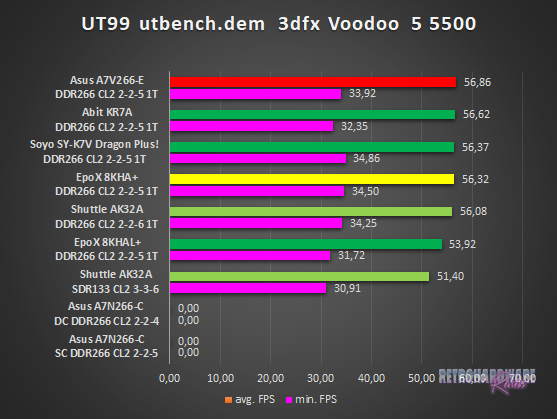
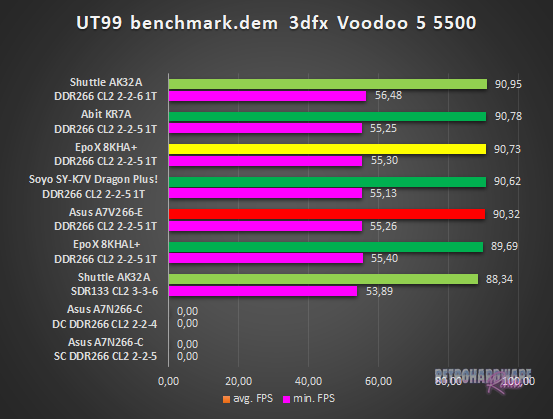
The KR7A-RAID ranks second in both tests with the Voodoo 5 installed. The minimum FPS shown in the utbench timedemo are a little on the low side compared to the other boards in the top five, though.
In the more GPU limited benchmark.dem timedemo, all the boards in this test perform virtually identical.
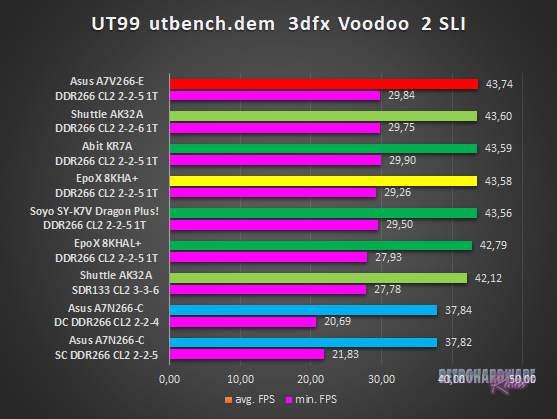
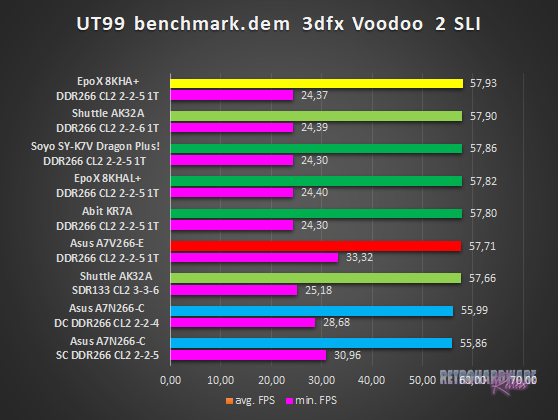
The results with the Voodoo 2 cards installed are very close in both timedemos. The Abit board ranks third and fifth here, but the performance is very similar to the respective first placed boards.
3D Performance: Quake III Arena Timedemo
Quake 3 Arena was released shortly after Unreal Tournament, in December of 1999. It is known to reward fast memory latency and with its normal preset, it is completely CPU limited; at least for the GeForce 4 and the Voodoo 5. The Voodoo 2 SLI cards clearly limit the Athlon 1200 here, as the timedemo will show.
- Version: 1.32
- Settings: “Normal” Preset, only resolution changed to 1024x768x16
- Geforce 5 and Voodoo5: OpenGL
- Voodoo 2: “Voodoo” Renderer (miniGL)
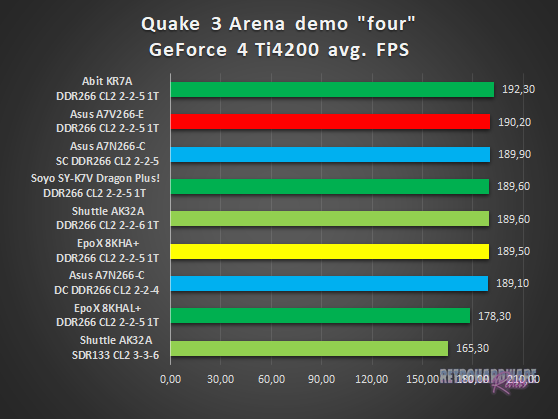
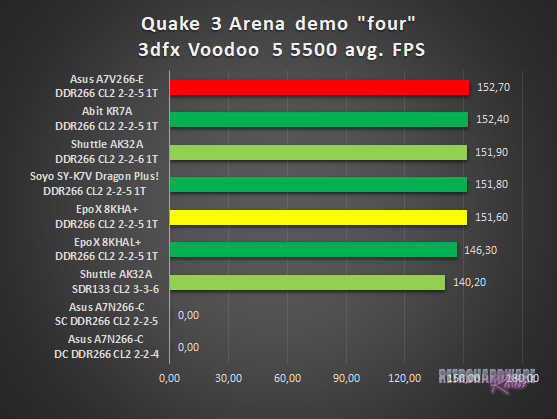
In Quake III Arena, we see very close results again. With both the GeForce 4 and the Voodoo 5 installed, most boards are less than 1 FPS apart.
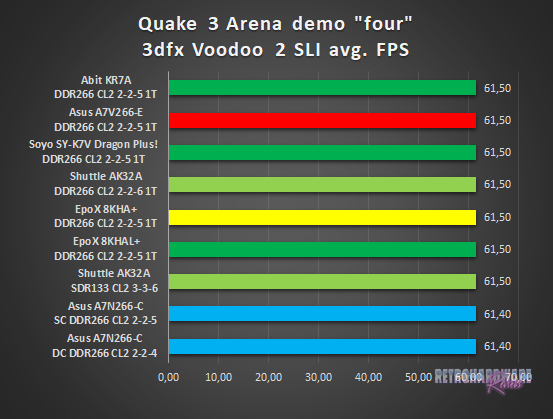
The Voodoo 2 SLI setup clearly limits here. All KT266A based boards score the same FPS, the nForce board is also just 0,1 FPS behind.
Summary & Rating
Abit KR7A-RAID (VIA KT266A)
-
Layout
-
Features
-
Overclocking Options
-
Compatibility
-
Documentation & Support
-
Performance: GeForce 4 Ti 4200
-
Performance: Voodoo 5 5500
-
Performance: Voodoo 2 SLI
OVERALL
| Pros | Cons |
| + Very high performance across all graphics cards tested | – CPU support could be better |
| + 4 RAM slots, support for Reg ECC memory | – CPU socket pretty close to top edge |
| + Lots of overclocking- and memory settings | |
| + Very good layout | |
| + Fantastic documentation |





